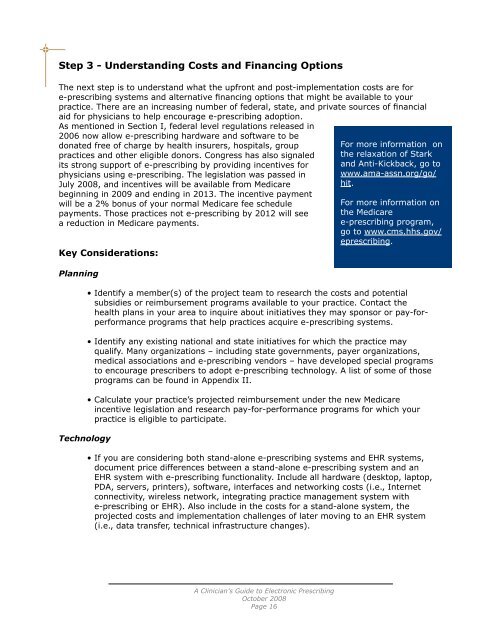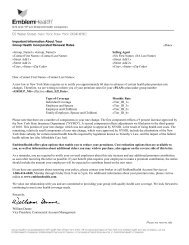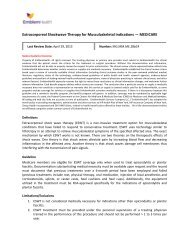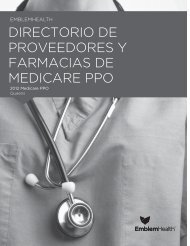A CLINICIAN'S GUIDE TO ELECTRONIC PRESCRIBING
A CLINICIAN'S GUIDE TO ELECTRONIC PRESCRIBING
A CLINICIAN'S GUIDE TO ELECTRONIC PRESCRIBING
You also want an ePaper? Increase the reach of your titles
YUMPU automatically turns print PDFs into web optimized ePapers that Google loves.
Step 3 - Understanding Costs and Financing Options<br />
The next step is to understand what the upfront and post-implementation costs are for<br />
e-prescribing systems and alternative financing options that might be available to your<br />
practice. There are an increasing number of federal, state, and private sources of financial<br />
aid for physicians to help encourage e-prescribing adoption.<br />
As mentioned in Section I, federal level regulations released in<br />
2006 now allow e-prescribing hardware and software to be<br />
donated free of charge by health insurers, hospitals, group<br />
practices and other eligible donors. Congress has also signaled<br />
its strong support of e-prescribing by providing incentives for<br />
physicians using e-prescribing. The legislation was passed in<br />
July 2008, and incentives will be available from Medicare<br />
beginning in 2009 and ending in 2013. The incentive payment<br />
will be a 2% bonus of your normal Medicare fee schedule<br />
payments. Those practices not e-prescribing by 2012 will see<br />
a reduction in Medicare payments.<br />
Key Considerations:<br />
Planning<br />
Technology<br />
For more information on<br />
the relaxation of Stark<br />
and Anti-Kickback, go to<br />
www.ama-assn.org/go/<br />
hit.<br />
For more information on<br />
the Medicare<br />
e-prescribing program,<br />
go to www.cms.hhs.gov/<br />
eprescribing.<br />
• Identify a member(s) of the project team to research the costs and potential<br />
subsidies or reimbursement programs available to your practice. Contact the<br />
health plans in your area to inquire about initiatives they may sponsor or pay-forperformance<br />
programs that help practices acquire e-prescribing systems.<br />
• Identify any existing national and state initiatives for which the practice may<br />
qualify. Many organizations – including state governments, payer organizations,<br />
medical associations and e-prescribing vendors – have developed special programs<br />
to encourage prescribers to adopt e-prescribing technology. A list of some of those<br />
programs can be found in Appendix II.<br />
• Calculate your practice’s projected reimbursement under the new Medicare<br />
incentive legislation and research pay-for-performance programs for which your<br />
practice is eligible to participate.<br />
• If you are considering both stand-alone e-prescribing systems and EHR systems,<br />
document price differences between a stand-alone e-prescribing system and an<br />
EHR system with e-prescribing functionality. Include all hardware (desktop, laptop,<br />
PDA, servers, printers), software, interfaces and networking costs (i.e., Internet<br />
connectivity, wireless network, integrating practice management system with<br />
e-prescribing or EHR). Also include in the costs for a stand-alone system, the<br />
projected costs and implementation challenges of later moving to an EHR system<br />
(i.e., data transfer, technical infrastructure changes).<br />
A Clinician’s Guide to Electronic Prescribing<br />
October 2008<br />
Page 16
















